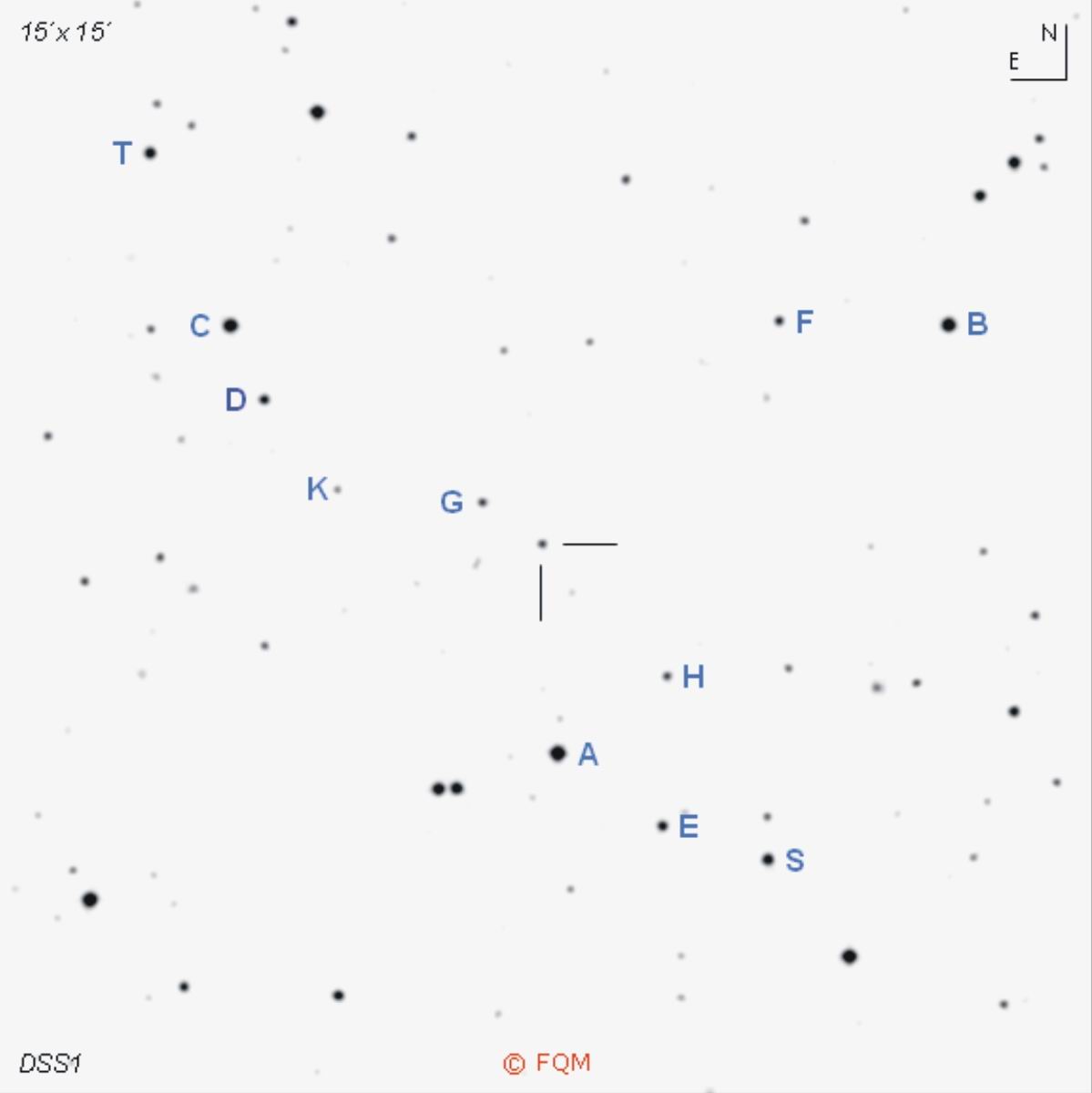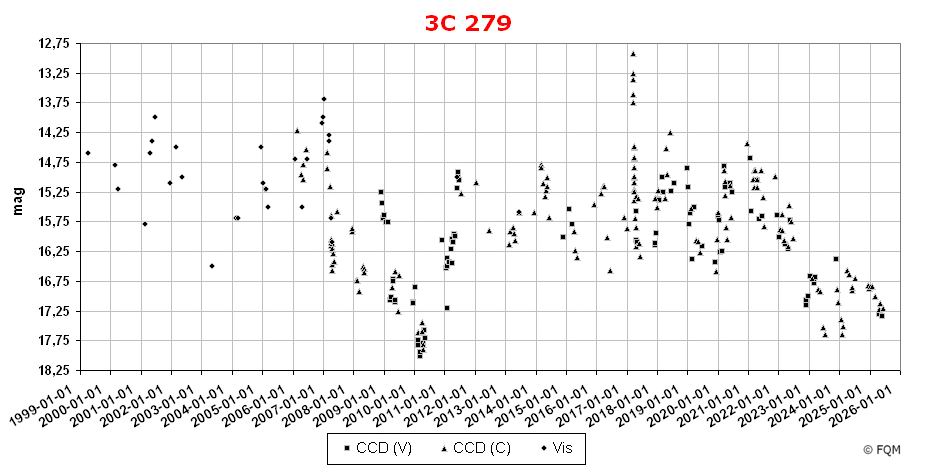
| Frankfurt Quasar Monitoring |
| 3C 279 |
| Cross-Identifications | 4C-05.55, PKS 1253-055, CTA 56, ON-089, 1253-055 LHE 334, MSH 12-020, NRAO 413, IRAS F12535-0530 RX J1256.1-0547, 1ES 1253-055, VSOP J1256-0547 WMAP J1256-0547, GeV J1256-0546, LEDA 2817645 2EG J1256-0546, HE 1253-0531, QSO B1253-055 2MASSi J1256111-054721, SWIFT J1256.1-0547 GALEXASC J125611.21-054721.2, 2E 2900 |
| Equat. coordinates | RA 12 56 11.1 DE -05 47 21 (J2000) |
| Constellation | Virgo |
| Type | QSO |
| Redshift
(2) |
z=0.536 |
| Distance (2) (3) |
1949 Mpc |
| Total mag range (mv) (4) | 11.3 - 18.0 |
| Catalog Magnitude (1) | 17.75 |
| Absolute Magnitude (1) | -24.6 MB |
| Light Travel-Time (2) | 5.136 × 109 yrs |

Comparison stars
| star | B | V | Rc | Ic |
| A | 13.011 | 12.411 | 12.051 | 11.701 |
| B | 13.421 | 12.811 | 12.441 | 12.121 |
| C | 13.741 | 12.991 | 12.551 | 12.171 |
| S | 14.6694 | 14.1464 | --- | --- |
| T | 15.6194 | 14.4744 | --- | --- |
| D | 15.471 | 14.901 | 14.531 | 14.201 |
| E | 16.373 | 15.143 | 14.443 | --- |
| F | 16.532 | 15.662 | 15.132 | --- |
| G | 16.821 | 15.941 | 15.451 | 15.001 |
| H | 17.7054 | 16.3154 | --- | --- |
| K | 18.9174 | 17.5724 | --- | --- |


| 3C
279 is a high
polarization quasar (HPQ) and one of the most violent variable sources
in the sky. It
is a
strong and violent variable from radio to gamma-rays.
This
OVV is very active with a total range of about 7 magnitudes (!) in the
optical. The
optical events show fast, spike-like flares with sharply raising
and falling fluxes.
3C
279 was the first quasar detected at energies of >1 GeV with
EGRET/CGRO. As a bright gamma
source it was, of course, also detected by
FERMI. High
resolution imagery of 3C 279 showed a core-jet structure with a jet
extending out to 10" to the SE.
All this activity is produced by a supermassive black hole of about 1×109
solar masses. The designation 3C 279 refers to the 3rd Cambridge Radio Survey (3C), where this object was discovered as a radio source in 1959. Its optical counterpart was identified with a faint v=17.75 "blue, starlike object", which was immediately classified as a quasar by spectroscopy (with some similarities of BL Lac-like objects). For both visual and CCD observers, 3C 279 is an interesting target at any time. During the short outbursts, visual observers with telescopes of 8- to 10-inch of aperture may have no difficulties to track down this quasar. Visually, 3C 279 remains a stellar object even with large aperture telescopes. In the past 25 years, the Frankfurt Quasar Monitoring programme has recorded optical outbursts reaching maxima between mag 12.9 and mag 14.7. CCD observers, as well as visual observers, may use the comparison stars given above. Other photometric sequences were published by Doroshenko et al. (2005), Gonzŕlez-Pérez et al. (2001) and the BAAVSS. ____________
Visual
observers may also like to visit close double star Struve 690 (STF) =
ADS 8707, only 1° to the north of 3C 279. It
consists
of a 7.2-mag primary and an 8.9-mag
secondary, separated by 5.7 arcsec.
For
deep sky observers
the near vicinity of 3C 279 offers two bright and large galaxies, both
members of the Virgo galaxy cluster:
NGC
4697 is a 10.1-mag elliptical, 1.9° W of 3C
279. NGC 4731,
only 1.4° to the SW, is a
distorted barred spiral due to gravitational interaction with
elliptical NGC 4697.
You like another deep sky showpiece? Sweep your telescope some 7° to the SW and you will meet M104, the famous "Sombrero Galaxy". Stargazers who prefer to observe more very old quasi-stellar photons are advised to turn their scopes to the most famous quasar of all: quasar "superstar" 3C 273, located some 10° NW of 3C 279. 3C 273 is an exceptionally bright 13-mag object at a distance of nearly 2×109 light-years. Another variable 15-mag quasar, PKS 1302-102, can be found about 5.3° SE. |
| Burbidge, E.M., Rosenberg, F.D. 1965, ApJ, 142, 1673; The Redshift of the Quasi-Stellar Radio Source 3C 279. Cheng, K.S., Fan, J.H., Zhang, L. 1999, A&A, 352, 32; Basic properties of gamma-ray loud blazars. Doroshenko, V.T., Sergeev, S.G., et al. 2005, Ap, 48, 304D; BVRI CCD-Photometry of Comparison Stars in the Neighborhoods of Galaxies with Active Nuclei. II Eachus, L.J., Liller, W. 1975, ApJ, 200, L61; Photometric Histories of QSOs: 3C 279, the most variable and possibly most luminous QSO yet studied. Ehman, J.R., Dixon, R.S., et al. 1970, AJ, 75, 351; The Ohio Survey between 0 and -36 degrees. Ellingson, E., Yee, H.K.C., Green, R.F. 1991, ApJS, 76, 455; QSO's and AGN in rich environments. Gonzŕlez-Pérez, J.N., Kidger, M.R., et al. 2001, AJ, 122, 2055; Optical and Near-Infrared Calibration of AGN Field Stars: An All-Sky Network of faint Stars calibrated on the Landolt System. Karge, S., 2005; Helle Quasare für 8- bis 10-Zoll Teleskope. Ein Beobachtungsführer zur visuellen Beobachtung von Quasaren und BL Lacertae Objekten. Katajainen, S., Takalo, L.O., et al. 2000, A&AS, 143, 357; Tuorla quasar monitoring. I. Observations of 1995-1997. Kinman, T.D. 1967, ApJ, 148, L53; Optical Polarization Measures of Five Radio Sources. Lynds, C.R., Stockton, A.N. et al. 1965, ApJ, 142, 1667; New Spectroscope Observations of Quasi-Stellar Sources. Makino, F., Kii, T., et al. 1989, AJ, 347, L9; X-Ray Outburst of the Quasar 3C279. Nilsson, K., Pursimo, T. et al. 2009, A&A, 505, 601; The host galaxy of 3C 279. Pica, A.J., Smith, A.G., Webb, J.R. et al. 1988, AJ, 96, 4; Long-term optical behavior of 144 compact extragalactic objects: 1969-1988. Raiteri, C.M., Villata, M., et al. 1998, A&AS, 130, 495; BVR photometry of comparison stars in selected blazar fields, II: Photometric sequences for 9 quasars. Rantakyro, F.T., Baath, L.B., et al. 1998, A&AS, 131, 451; 50 MU as resolution VLBI images of AGN's at lambda 3 mm. Sandage, A., Veron, P., Wyndham, J. 1965, ApJ, 142, 1307; Optical Identification of New Quasi-Stellar Radio Sources. Sandage, A., Wyndham, J. 1965, ApJ, 141, 328; On the Optical Identification of eleven new Quasistellar Radiosources. Shrader, C.R., Webb, J.R., et al. 1994, AJ, 107, 3; Optical and Ultraviolet Observations of 3C279 during outburst. Smith, P.S., Balonek, T.J. 1998, PASP, 110, 1164; Photometric Calibration of Stars in the Fields of Selected BL Lacertae Objects and Quasars. Tadhunter, C.N., Morganti, R., et al. 1993, MNRAS, 263, 999; Optical spectroscopy of a complete sample of southern 2-Jy radio sources. Ulrich, M.-H., Maraschi, L., et al. 1997, Ann. Rev. Astr. Ap., 35, 445; Variability of Active Galactic Nuclei. Véron-Cetty, M.-P., Véron, P. 2001, A&A 374, 92; A Catalogue of Quasars and Active Nuclei: 10th edition. Véron-Cetty, M.-P., Véron, P. 2003, A&A 412, 399; A Catalogue of Quasars and Active Nuclei: 11th edition. Véron-Cetty, M.-P., Véron, P. 2006, A&A 455, 776; A Catalogue of Quasars and Active Nuclei: 12th edition. Véron-Cetty, M.-P., Véron, P. 2010, A&A 518, 10; A Catalogue of Quasars and Active Nuclei: 13th edition. Villata, M., Raiteri, C.M., et al. 1997, A&AS, 121, 119; Optical photometric monitoring of (gamma)-ray loud blazars.I. Webb, J.R., Carini, M.T., et al. 1990, AJ, 100, 1452; The 1987-1990 optical outburst of the OVV Quasar 3C 279. Wyndham, J. 1965, AJ, 70, 384; A Search for Optical Objects Associated with 50 Radio Sources. Xie, G.Z., Zhou, S.B., Liang, E.W. 2004, AJ, 127, 53; The Mass-Luminosity Relation, Accretion Rate-Luminosity Relation, and Evolutionary Sequence of Blazars. |
| Links: Landessternwarte Heidelberg Hamburg Quasar Monitoring Chara/PEGA BAAVSS AAVSO AAVSO observing campaign |
| home |